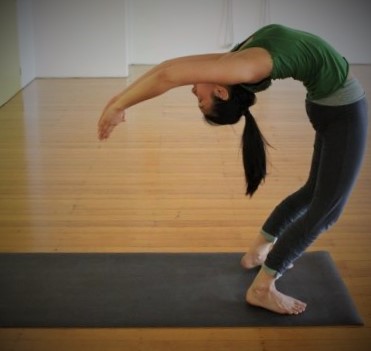The lifestyle of the typical modern day office worker lends itself to back pain. Unfortunately, over my years teaching yoga, I would estimate that at least one in four students has some sort of back problem; globally, back pain is the foremost contributor to disability (Institute for Health Metrics and Evaluation. “2010 Global Burden of Disease Study”).
Marichyasana C. Twist evenly from the base of the spine right up to the top of the neck. Photograph by Gray Gilbert.
Cultivating awareness and proper posture are crucial for combatting back pain, and luckily, there are things you can do in class to help. Mula bandha and uddiyana bandha should be engaged throughout your entire practice. These bandhas work in unison, increasing the internal pressure around your spinal column, and thus helping to protect your spine from injury.
- Mula bandha: Draw your pelvic floor upward slightly
- Uddiyana bandha: Draw your lower abdominal muscles (about 2 inches below the navel) inward and upward
General guidelines for yoga with back pain
- Forward bends: Bend your knees slightly and try not to round your back forward. Inhale, engage bandhas, then lengthen your spine and lift up from your chest; exhale, tilt forward from your hips.
- Backbends: In backbends, it’s quite natural for your body to bend more easily in the lower back due to the natural S-curve of the spine. However, especially in those with lower back pain, this can cause compression of the vertebrae (typically L4 or L5) – aim to bend more from your upper back to counteract this and always engage your bandhas before going into a backbend. Inhale, expand your chest; exhale, tuck your tailbone under and lead your sternum in the opposite direction.
- Twists: Ensure that you keep your spine long and go slowly, twisting evenly from the base of the spine right up to the top of your neck. Engage your bandhas. Inhale, lengthen your spine; exhale, twist.
- Side bends: Always keep your spine long and move with your breath. As always, bandha up first! Inhale, lengthen your spine; exhale, move into the pose, making sure you are bending uniformly over your entire spine.
Photograph by Jude Hynes.
Pay close attention throughout your practice – if it hurts, modify! Don’t be scared to talk to your teacher about any concerns or if you have any questions.
Tip: Engage mula bandha and uddiyana bandha and bend your knees when lifting heavy objects to help protect your back. In fact, if you currently have back pain, it can be beneficial to engage these bandhas throughout the day – I liken it to adding a layer of bubble wrap around your spine – a) it helps to support your spine, preventing further injury, and b) it strengthens your core, which further helps to improve your posture.
In short: awareness + bandhas bandhas bandhas!

